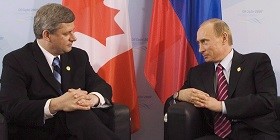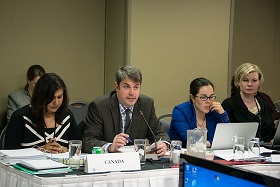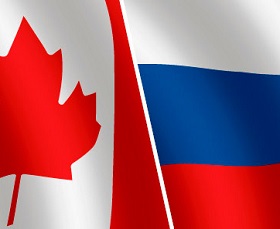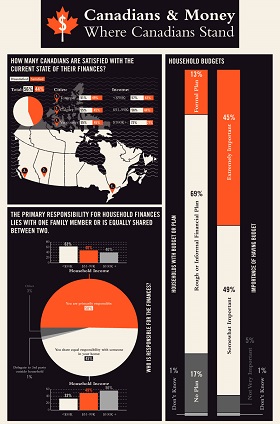Canada: From a Backward Colony to a Vibrant Democracy
In
Login if you are already registered
(no votes) |
(0 votes) |
PhD in History, Leading Researcher at RAS Institute for U.S. and Canadian Studies
On July 1 Canadians celebrate Canada Day, their main national holiday commemorating the British North America Act signed on July 1, 1867 establishing the British Dominion of Canada. On this day, people often say that Canada has too much geography and too little history, and this is an apt moment to contemplate whether this maxim reflects the historical experience of a country that made the transition from colonialism to robust democracy, how Canada today is relevant to Russia, and the two countries’ broader bilateral relationship.
On July 1 Canadians celebrate Canada Day, their main national holiday commemorating the British North America Act signed on July 1, 1867 establishing the British Dominion of Canada. On this day, people often say that Canada has too much geography and too little history, and this is an apt moment to contemplate whether this maxim reflects the historical experience of a country that made the transition from colonialism to robust democracy, how Canada today is relevant to Russia, and the two countries’ broader bilateral relationship.
Initially, the Dominion incorporated four British colonies: [1] Ontario, Quebec, Nova Scotia, and New Brunswick, which were later augmented by six more provinces and three territories. The 1982 Constitution Act transferred the Constitution to the Canadian Parliament’s jurisdiction, effectively completing the country’s long path to full sovereignty and independence from the United Kingdom. From 1982, Canada Day replaced the previously celebrated Dominion Day.
A Mari Usque Ad Mare: Components of Success
In contrast to certain European countries, Canada’s highly nuanced and generously financed multiculturalism is universally acknowledged as a government achievement.
A Mari Usque Ad Mare – from Sea to Sea – is Canada's national motto. Inscribed on its coat of arms, it depicts the country's particular geography. With the second largest territory after Russia, Canada’s shores meet three oceans – the Pacific, the Atlantic and the Arctic – and is fabulously rich in resources. As a matter of fact, the country is the world’s largest producer and exporter of uranium ore and potassium, the second in nickel, grain and hydroelectric power, and the third in oil and diamonds, its lands holding 10 percent of the global forests and seven percent of potable water.
Canada is a G7 member with an advanced, open, and diversified economy that demonstrated high resilience during the 2008-2009 global economic and financial disaster. The recession came later than in other G7 countries and was on a smaller scale, with analysts predicting steady GDP growth for the country: 2.3 percent in 2014 and 2.5 percent in 2015 (Financial Post, May 7, 2014)
Canada is also famous for its high living standards and quality of life, topping the UN Human Development Index eight times in the 1990s. In the 2013 Report, the country rolled down to 11th place but is still among the leaders.
The Canadian practice of building federal and provincial relations is particularly interesting. The country is a decentralized federation with strong regional government, and the two authorities interact harmoniously within the double sovereignty system.
Canada’s socio-political and cultural landscape is distinctively multi-ethnic. Known as the country of immigrants, Canada annually receives 225-250 thousand newcomers, about 0.8 percent of its total population [2]. Ethnic minorities are united by a national idea and consider themselves Canadians, proud of belonging to their ethnic group and unwilling to assimilate with any other community, as was found in the 2003 national survey of Statistics Canada. This is the difference between Canada’s cultural mosaics and the U.S. melting pot. In contrast to certain European countries, Canada’s highly nuanced and generously financed multiculturalism is universally acknowledged as a government achievement.
The Downside
Despite the plentiful natural riches and numerous accomplishments, Canada is also rife with problems.
First comes excessive economic and trade dependence on the United States. Institutionalized by the tripartite North American Free Trade Agreement (or NAFTA, the third country is Mexico) dating back to 1994, U.S.-Canadian integration brings Ottawa both palpable economic dividends, such as access to the huge North American market, defense against U.S. protectionism, and regulated relationships with Washington and Mexico City, but it also involves significant problems. After the economic turmoil of 2008-2009, Canada’s elites realized the inexpediency and even risks of this complete alignment with the U.S. economy., Canada proved more resilient to the recession than the United States, with the Canadian economy returning to growth in April 2009 and surpassing the pre-crisis low in mid-2010 [3]. Recent events, especially the White House’s refusal in January 2012 to authorize the construction of new segments of the Keystone XL oil pipeline from Alberta to the U.S. [4] , have made the Canadians realize the depth of problems arising from their dependence on that one sole export market. Ottawa turned to Asia with a view to diversifying its oil exports, and in 2012 signed a long-expected agreement with China on the advancement and protection of foreign investment [5], joined the Trans-Pacific Partnership, and in March 2014 entered into a free trade agreement with South Korea. In October 2013, the Comprehensive Economic and Trade Agreement was concluded between Canada and the European Union (The Globe and Mail, October 18 2013)
Canada proved more resilient to the recession than the United States.

Prime Minister Stephen Harper meets Russian
President Vladimir Putin
The second issue is French-speaking Quebec, which demands constitutional recognition for the French Canadian nation, with its profound individuality, vivacious national self-consciousness and unwavering democratic traditions. In the absence of a relevant clause in the 1982 Constitution, Quebec refused to sign the document, while its subsequent attempts to obtain constitutionally grounded special status failed. In an attempt to vent steam, in 2006 Ottawa allowed Quebec to participate in UNESCO, while Parliament adopted a resolution on recognizing Quebec as a nation within the federation (Associated Press, November 28, 2006). Elections in Quebec last April showed weaker separatist sentiment, as the pro-sovereignty ruling Parti Quebecois suffered a crushing defeat, and its leader Pauline Marois even lost her own constituency and was forced to resign. The Liberals won 41.5 percent of the vote, giving them 70 out of 125 districts, while the Parti Quebecois only won 25 percent of the vote in 30 districts (The Globe and Mail April 7, 2014). But the French Canadian problem retains a certain degree of urgency and can only be resolved through the constitutional recognition of the indisputable existence of the two cultures.
Thirdly, Ottawa still cannot resolve relations with the indigenous peoples, Canada’s First Nations. International experts have found numerous violations of the norms and standards adopted for this group, such as non-observance of their territorial, socio-economic, political, and resource rights. Their claims to traditional lands, most of which have been rejected by the government over the past two decades, are of particular significance. Indigenous women suffer from heightened discrimination, with lower life expectancy, health and education indicators vis-à-vis other groups of women. Unemployment among this group is double that of other groups, and the incidence of domestic violence is three times higher (Women in Canada 2010-2011. Ottawa dodged the 2007 UN Declaration of the Rights of Indigenous Peoples, joining late and with certain reservations.
The Russia-Canada Vector
Despite differences on the delimitation of the Arctic continental shelf and the status of Lomonosov and Mendeleyev ridges, the two countries’ interests often coincide.

The relationship between Moscow and Ottawa has a long history and time-honored traditions. Diplomatic relations were established in 1942, when the two countries were members of the anti-Hitler coalition. Canada was one of the first in the West to recognize Russia as the successor of the USSR in the international arena. Leaders of the two states have repeatedly expressed satisfaction with the status and dynamics of this interaction, while also noting with regret that their full potential is largely untapped.
After the conservative government of Stephen Harper came to power in 2006, the dialogue has been quite chilly, with bilateral trade dropping to USD 2.6 billion in 2011, i.e. a very low level, which is in the vicinity of the daily U.S.-Canadian figure (Russian-Canadian Economic and Trade Relations. The two governments also differ on such key international issues as Syria, Iran and the Middle East, and can hardly boast prolific bilateral contacts. However, there is also the bright side, as trade and investments grew by 51.4 percent from 2009 to 2010 (Russian-Canadian Economic and Trade Relations. // Ibid.’), while Statistics Canada puts Canadian FDI in Russia at 4.8 billion dollars (The Globe and Mail, Mar. 28 2014)
There seem to be good prospects for cooperation over the Arctic. Despite differences on the delimitation of the Arctic continental shelf and the status of Lomonosov and Mendeleyev ridges, the two countries’ interests often coincide. While the United States claims that the Northern Sea Route and North-West Passage are international waters, Russia and Canada regard them as their territorial seas. Moscow and Ottawa have ratified the 1982 UN Convention on the Law of the Sea, something Washington has yet to do. Russia and Canada cooperate on telecommunications, construction, agriculture, protecting the culture and traditions of the Northern peoples, the environment, and tourism. Both are active and creative members of the Arctic Council and maintain contacts within the Arctic Five group of littoral states comprising Denmark, Canada, Norway, Russia and the United States. The 2011 Agreement on Cooperation in Aeronautical and Maritime Search and Rescue also appears to provide a healthy basis for joint activities for Russia, Canada, and the other Arctic states.
Canada is one of the most actively anti-Russian countries and was the first to impose sanctions against Russian and Ukrainian politicians. Ottawa has also suspended its participation in the Russian-Canadian Intergovernmental Economic Commission and shirked the session of the Arctic Council in Moscow.
Some business projects are delivering results, and include SNC-Lavalin construction and engineering, Kinross Gold, which has become the second largest gold producer in Russia, Bombardier, which purchased shares in the signal equipment manufacturer from Russian Railways and joined Rostec in a project to produce turboprop aircraft in Ulyanovsk (Vedomosti, March 21, 2014).
These positive trends and opportunities may end up being lost over events in Ukraine, which have generated the worst bilateral crisis since the Cold War. Canada is one of the most actively anti-Russian countries and was the first to impose sanctions against Russian and Ukrainian politicians. These measures currently affect over 60 officials and 19 organizations, including two banks, Expobank and RosEnergoBank (CBC News, May 13, 2014). Ottawa has also suspended its participation in the Russian-Canadian Intergovernmental Economic Commission and shirked the session of the Arctic Council in Moscow, a key step, since Canada currently chairs the organization. The delegation of Alberta province was the only Western entity to turn down the invitation to the Moscow World Oil Congress held in June 2014 (Rossiyskaya Gazeta, June 16, 2014). Military cooperation was also suspended, (covering all joint exercises, visits and talks) while Russian servicemen staying in Canada under an exchange program were expelled. Canada has also built up its NATO-based military presence in Europe, moving six CF-18 fighters to Romania, a frigate to the eastern Mediterranean, and troops to Latvia and Poland (The Globe and Mail. June 04 2014). Diplomatic measures were also applied, including the recall of Ambassador John Kerr from Moscow last March, who returned in early April, and the expulsion of a Russian military attaché assistant from Ottawa. The Canadian government's rhetoric about Russian policies often sounds unreasonably harsh (CBC News: Marсh 04, 2014).

Given the upcoming October 2015 federal elections, the Conservatives clearly care about the Ukrainian community.
What factors affect Canada's approach to the Ukraine crisis? Primarily, this refers to the U.S., the driving force behind anti-Russian sanctions. Ottawa not coordinates its international steps with Washington but also frequently runs its errands, as the White House offloads difficult jobs to its northern ally, as seems to be the case with sanctions. In the absence of sufficient support from its European allies, the U.S. brought in its closest and most reliable partner.
Besides, Canada has its own interests in the energy dialogue between Russia and the West, with huge energy resources and richly earning from oil and gas sales (about 14 percent of national exports) [6]. Striving to diversify its hydrocarbon exports, Ottawa views Russia as a competitor and wants to use sanctions to oust it from the European markets.
The response of the Ukrainian diaspora, demanding more pressure on Russia, is also vital. The 1.2-million-strong Ukrainian community, the ninth largest in Canada, is one of the country’s most coherent and vocal. Canada has always been highly considerate regarding Ukraine, and was the first to recognize it in 1991. Since then Ottawa has been very persistent in bringing Kiev into NATO, and has provided the Yatsenyuk government with a 220-million-dollar assistance package (The Huffington Post Canada 05/06/2014), while Mr. Harper was the first G7 leader to visit Kiev after the ouster of President Yanukovich. Given the upcoming October 2015 federal elections, the Conservatives clearly care about the Ukrainian community’s vote, since west Canada, where there is a heavy concentration of Ukrainian immigrants, is their key electoral base.
Cautious optimism seems the right approach when looking to the future, with the following factors seeming to be in favor of the revival of dialogue between the two countries. First, previous experience has been time-tested and still offers fairly good potential for progress despite certain complexities and differences. Second, Canadian firms are still interested in business cooperation, for example, sanctions could deprive Bombardier of an aircraft supply contract worth 3.4 billion dollars (Globe and Mail, May 22, 2014). Third, the Northern and Arctic problems are too important on both countries’ economic development and international agendas to be impacted long-term.
According to Canadian experts, Ottawa is reasonably reserved within the Arctic Council, in order to prevent the Ukraine issue from having an excessive influence on its deliberations (Embassy, 04/09/2014) and there is therefore hope that the abrupt cooling in relations will not last long.
Bibliography
1. Canada had been a French colony until 1763.
2. Shane K., Immigration Consultations: Politics or Policy? // Embassy. July 27, 2011
3. Economy and Politics of Canada / Science Editor V.I. Sokolov. Moscow: RAS Institute for U.S. and Canadian Studies, 2013, P.93
4. There are numerous reasons for President Obama's suspension of the project, including infighting among America’s oil lobby, doubts in Congress, environmentalists' protest and electoral worries about future pollution.
5. Israelyan E.V., Yevtikhiyevich N.S., Cultural Aspects of Canada's Foreign Policy. RAS Institute for U.S. and Canadian Studies, 2013, P. 123
6. Economy and Politics of Canada / Science Editor V.I. Sokolov. Ibid, P. 189
(no votes) |
(0 votes) |





